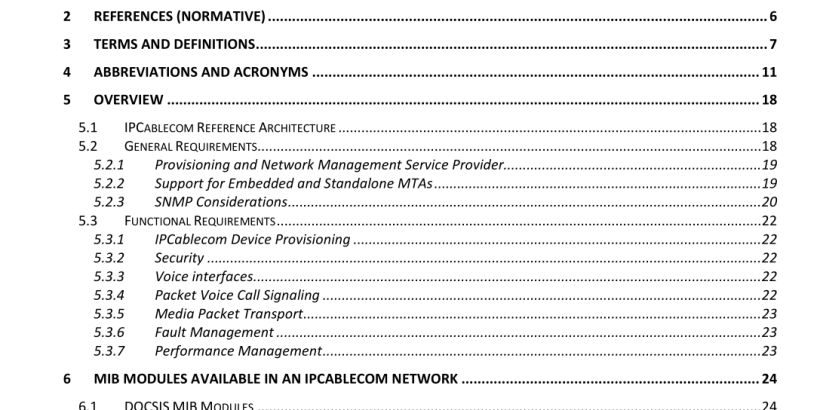ANSI SCTE 24-6-2016 pdf download.Management Information Base (MIB) Framework
1.1 Purpose
This standard describes the framework in which IPCablecom MIB (Management Information Base) modules are described. It provides information on the management requirements of IPCablecom compliant devices and functions and how these requirements are supported in the MIB modules. It is intended to support and complement the actual MIB module documents, which are issued separately. This document addresses some aspects of the voice communications capabilities of an IPCablecom network. The legal/regulatory classification of IP-based voice communications provided over cable networks and otherwise, and the legal/regulatory obligations, if any, borne by providers of such voice communications, are not yet fully defined by appropriate legal and regulatory authorities. Nothing in this specification is addressed to, or intended to affect, those issues. In particular, while this document uses standard terms such as “call,” “call signaling,” “telephony,” etc., it will be evident from this document that while a Packet-Cable network performs activities analogous to these PSTN functions, the manner by which it does so differs considerably from the manner in which they are performed in the PSTN by telecommunications carriers. These differences may be significant for legal/regulatory purposes.
1.2 Requirements and Conventions
Throughout this document, the words that are used to define the significance of particular requirements are capitalized. These words are:This word or the adjective“REQUIRED” means that the item is an absolute requirement of this specification. . This phrase means that the item is an absolute prohibition of this specification. This word or the adjective“RECOMMENDED” means that there may exist valid reasons in particular circumstances to ignore this item, but the full implications should be understood and the case carefully weighed before choosing a different course. This phrase means that there may exist valid reasons in particular circumstances when the listed behavior is acceptable or event useful, but the full implications should be understood and the case carefully weighed before implementing any behavior described with this label. This word or the adjective“OPTIONAL” means that this item is truly optional. One vendor may choose to include the item because a particular marketplace requires it or because it enhances the product, for example; another vendor may omit the same item.
2 REFERENCES (NORMATIVE)
The following documents contain provisions which, through reference in this text, constitute provisions of this standard. At the time of Subcommittee approval, the editions indicated were valid. All documents are subject to revision, and while parties to agreement based on this standard are encouraged to investigate the possibility of applying the most recent editions of the documents listed below, they are reminded that newer editions of those documents might not be compatible with the referenced version.
3 TERMS AND DEFINITIONS
The following is a master list terms and definitions used by IPCablecom 1.0:Limiting the flow of information from the resources of a system only to authorized persons, programs, processes, or other system resources on a network. A service flow is said to be “active” when it is permitted to forward data packets. A service flow must first be admitted before it is active. A service flow is said to be “admitted” when the CMTS has reserved resources (e.g., bandwidth) for it on the DOCSIS network. A-Links are SS7 links that interconnect STPs and either SSPs or SCPs.‘’A’ stands for ” Access.’ An encryption key or a decryption key used in public key cryptography, where encryption and decryption keys are always distinct. An Audio Server plays informational announcements in IPCablecom network. Media announcements are needed for communications that do not complete and to provide enhanced information services to the user. The component parts of Audio Server services are Media Players and Media Player Controllers. The process of verifying the claimed identity of an entity to another entity. The ability to ensure that the given information is without modification or forgery and was in fact produced by the entity that claims to have given the information. The act of giving access to a service or device if one has permission to have the access. An algorithm that transforms data between plaintext and ciphertext. A set which must contain both an encryption algorithm and a message authentication algorithm (e.g., a MAC or an HMAC). In general, it may also contain a key-management algorithm, which does not apply in the context of IPCablecom. , The (encrypted) message output from a cryptographic algorithm that is in a format that is unintelligible.ANSI SCTE 24-6-2016 pdf download
